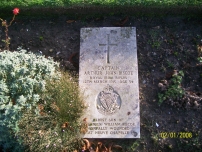| First Name: | Arthur John | Last Name: | BISCOE | |
|---|---|---|---|---|
| Date of Death: | 12/03/1915 | Lived/Born In: | Blackheath | |
| Rank: | Captain | Unit: | Royal Irish Rifles1 | |
| Memorial Site: | Blackheath, All Saints | |||
Current Information:Age-34 Boulogne Eastern Cemetery, France
The Battle of Neuve Chapelle Between 10th and 13th March, 1915, the Indian Army Corps and IV Corps attacked the village of Neuve Chapelle in the Artois region of France. During the winter of 1914-1915, reinforcements had arrived from Britain and this was seen as an opportunity to use them to break through the German lines. It started well. At 7.30am on 10th March, a 30 minute hurricane bombardment destroyed the German wire and front line trenches and at 8.05am the infantry went in. Neuve Chapelle was captured and over a mile of the German line taken. But that was the end of the success. The British chain of command was weak and their communications poor, which was hardly surprising given that many of the troops had no previous experience of battle. The Germans re-organised and reinforced during the night and no further gains were made. British casualties mounted to 12,000 by the time the offensive petered out on 13th March. Leading the attack of 25th Brigade, 8th Division on 10th March were 2nd Lincolnshire and 2nd Royal Berkshire attacking on a 400 yard front. They moved across No Man’s Land with little loss, took the German front trench and by 8.20am they had reached the German support line. At 8.35am, the 2nd Rifle Brigade and 1st Royal Irish Rifles battalions started forward as the British artillery carried out the second stage bombardment of the village itself. At 8.35am, they had both passed through the leading battalions and moved on into the village of Neuve Chapelle. At first they met little opposition and within 15 minutes they had reached the Armentieres road where they pivoted on their right and worked their way through the orchards and houses in the Road Triangle north of the village. But with no other British troops moving forward on their left they were enfiladed from Mauquissart, a tiny group of house and from another group of houses 500yds further south and suffered heavily. Despite these losses, at 9.40am 1st Royal Irish Rifles were in a position on the east side of the Road Triangle and in touch with 2nd Rifle Brigade. At this point a company was swung back to guard their left flank which was vulnerable after the advance of 23 Brigade had been held up. With the help of 2nd Field Company of the Royal Engineers trenches were dug and wire erected. At 9am on 11th March they were relieved from the front line and moved back to support trenches but still coming under heavy artillery fire and still suffering casualties. Then, on 12th March they were ordered to renew their attack and at 9am they moved into position in Neuve Chapelle only to have the attack postponed. Fog had prevented an artillery barrage of the enemy trenches but the German guns were able to target them as they waited with the inevitable casualties ensuing. The delayed bombardment finally started at noon and 45 minutes later the attack was launched but straight away ran into trouble. It was met by heavy frontal and flanking fire and very few made any progress. Another attempt at 5pm met similar results and eventually, after heavy losses, 1st Royal Irish Rifles were withdrawn to support positions and on the following day were relieved. Their casualty list for the three days of the battle amounted to over 400 and included Arthur Biscoe who was wounded on 10th March and died from his wounds two days later after he had been tasken back to a base hospital in Boulogne. |
||||
| « Back to Search Results | ||||
| If you think any of the information shown here is incorrect, Click Here to submit your amends and comments | ||||




